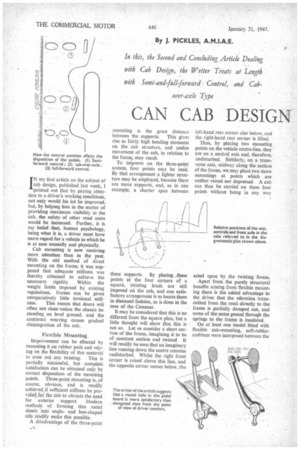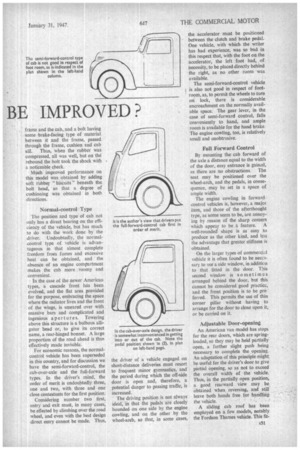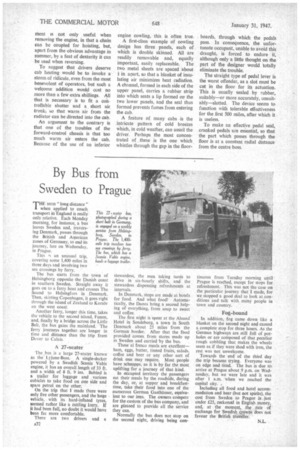CAN CAB DESIGN BE IMPROVED?
Page 32

Page 33

Page 34

If you've noticed an error in this article please click here to report it so we can fix it.
In this, the Second and Concluding Article Dealing with Cab Design, the Writer Treats at Lekgth with Semi-and-full-forward Control, and Cabover-axle Type
By J. PICKLES, A.M.I.A.E.
IN my first article on the subject of cab design, published last week, I pointed out that by paying attention to a driver's working conditions, not only would his lot be improved, but, by helping him in the matter of providing maximum visibility in the cab, the safety of other road users would be increased. Further, it is my belief that, human psychology, being what it is, a driver must have more regard for a vehicle in which he is at ease mentally and physically_ Cab mounting is now receiving more attention than in the past. With the old method of direct mounting on the frame, it was supposed that adequate stiffness was thereby obtained to achieve the necessary rigidity. Within the weight limits imposed by existing regulations, frames can be given comparatively little torsional stiff ness. This means that doors will often not close sinless the chassis be standing on level ground, and the continual weaving causes gradual disintegration of the cab.
Flexible Mounting Improvement can be effected by mounting it on rubber pads and relying on the flexibility of this material to even out any twisting. This is partially successful, but complete satisfaction can be obtained only by correct disposition of the mounting points. Three-point mounting is, of course, obvious, and is readily achievect.if sufficient stiffness be provided,for the cab to obviate the need for exterior support. Modern methods of forming thin metal sheets into angleand box-shaped sills.readily make this possible.
A disadvantage of the three-point mounting is the great distance between the supports. This gives rise to fairly high bending moments on the cab structure, and undue movement of the cab, in relation to the frame, may result.
To improve on the three-point system, four points may be used. By that arrangement a lighter structure may be employed, because there are more supports, and, as in one example, a shorter span between these supports. By placing -these points at the four corners of a square, twisting loads are still imposed on the cab, and one satisfactory arrangement is to locate them in diamond fashion, as is done in the case of the Commer.
It may be considered that this is no different from the square plan, but a little thought will show that this is not so. Let us consider a short section of the frame, imagining it to be of constant section and twisted. It will readily be seen that an imaginary line running down the centre remains undisturbed. Whilst the right front corner is raised above this line, and the opposite corner comes below, the left-hand rear corner also below, and the right-hand rear corner is lifted.
Thus, by placing two mounting points on the vehicle centre-line, they are on a neutral axis and, therefore, undisturbed. Similarly, on a transverse axis, midway along the section of the frame, we may place two more mountings at points which are neither raised nor depressed. A cab can thus be carried on these four points without being in any wt-t!,, acted upon by the twisting forces.
Apart from the purely structural benefits arising from flexible mounting there is the added advantage to the driver that the vibration transmitted from the road directly to the frame is partially damped out, and some of the noise passed through the springs to the frame is insulated.
On at least one model fitted with flexible cab-mounting, soft-rubber cushions were interposed between the frame and the tab, and a bolt having some brake-facing type of material between it and the frame, passed through the frame, cushion and cab sill. Thus, when the rubber Was compressed, all was well, but on the rebound the bolt took the shock with a noticeable check.
Much improved performance on this model was obtained by adding soft rubber " biscuits " beneath the bolt head, so that a degree of cushioning was obtained in both directions.
Normal-control Type The position and type of cab not only has a direct bearing on the efficiency of the vehicle, but has much to do with the work done by the driver. Undoubtedly, the normalcontrol type of vehicle is advantageous in that almost complete freedom from fumes and excessive heat can be obtained, and the absence of an engine compartment makes the cab more • roomy and convenient.
In the case of the newer American types, a cascade front hds been evolved, and the flat area .provided for the purpose, embracing the space where the radiator lives and the front of the wings, is smeared over with massive bars and complicated and ingenious aperture s. Towering above this structure is a bulbous alligator head or, to give its correct name, a rear-hinged bonnet. A large proportion of the road ahead is thus effectively made invisible.
• For economic reasons, the normalcontnal vehicle has been superseded in this country, and for discussion we have the semi-forward-control, the cab-over-axle and the full-forward types. In the driver's mind, thc order of merit is undoubtedly three, one and two, with three and one close contestants for the first position.
Considering number two first, entry and exit must, in many cases, be effected by climbing over the road wheel, and even with the best design direct entry cannot be made. Thus, the driver of a vehicle engaged on short-distance deliveries must resort to frequent minor gymnastics, and the period during which the off-side door is open and, therefore, a potential danger to passing traffic, is increased.
The driving position is not always ideal, in that the pedals are closely bounded on one side by the engine cowling, and on the other by the wheel-arch, so that, in some cases,
the accelerator must be positioned between the clutch and brake pedal. One vehicle, with which the writer has had experience, was so bad in this respect that, with the foot on the accelerator, the left foot had, of necessity, to be placed directly behind the right, as no other room was available.
The semi-forward-control vehicle is also not good in respect of footroom, as, to permit the wheels to turn on lock, there is considerable encroachment on the normally available space. The gear lever, in the case of semi-forward control, falls conveniently to hand, and ample room is available for the hand brake. The engine cowling, too, is relatively small and unobtrusive.
Full Forward Control
By mounting the cab forward of the axle a distance equal to the width of the door, easy entrance is gained, as there are no obstructions. The seat may be positioned over the wheel-arch, and the pedals, in consequence, may be set in a space of ample width.
The engine cowling in forwardcontrol vehicles is, however, a major item, and those of the afterthought type, as some seem to be, are annoying by reason of the sharp corners which appear to be a feature. A well-rounded shape is as easy to produce as the other kind, and has the advantage that greater stiffness is obtained.
On the larger types of commercial vehicle it is often found to be necessary to use a side window, in addition to that fitted in the door. This second window is sometimes arranged behind the door, but this cannot be considered good practice, and the front position is to be preferred. This permits the use of thin corner pillar without having to arrange for the door to close upon it, or be carried on it.
Adjustable Door-opening An American van model has stops for the rear doors, which are springloaded, so they may be held partially open, a further slight push being necessary to complete the opening. An adaptation of this principle might be useful for the driver's door to give partial opening, so as not to exceed the overall width of the vehicle. Thus, in the partially open position, a good rearward view may be obtained when reversing, and still leave both hands free for handling the vehicle.
A sliding cab roof has been employed on a few models, notably the Fordson Thames vehicle. This fit ment is not only useful when removing the engine, in that a chain can be coupled for hoisting, but, apart from the obvious advantage in summer, by a feat of dexterity it can be used when reversing.
To suggest that drivers deserve cab heating would be to invoke a storm of ridicule, even from the most benevolent of operators, but such a welcome addition would cost no more than a few extra shillings. All that is necessary is to fit a controllable shutter and a short air trunk; so that warm air from the radiator can be directed into the cab.
An argument to the contrary is that one of the troubles of the forward-control chassis is that too much warm air enters the cab. Because of the use of an inferior engine cowling, this is often true.
A first-class example of cowling design has three panels, each of which is double skinned. All are readily removable and, equally important, easily replaceable. The two metal sheets are spaced about I in apart, so that a blanket of insulating air minimizes heat radiation. A channel, formed in each side of Ihe upper panel, carries a rubber strip into which seats a lip formed op the two lower panels, and the seal thus formed prevents fumes from entering the cab.
A feature of many cabs is the intricate pattern of cold breezes which, in cold weather, can assail the driver. Perhaps the most concentrated of these is the one which whistles through the gap in the floor boards, through which the pedals pass. In consequence, the unfortunate occupant, unable to avoid this draught, is forced to endure it, although only a little thought on the part of the designer would totally eliminate the trouble.
The straight type of pedal lever is the worst offender, as a slot must be cut in the floor for its actuation. This is usually sealed by rubber, suitably—or more accurately, unsuitably—slotted. The device seems to function with tolerable effectiveness for the first 500 miles, after which it is useless.
To make an effective pedal seal, cranked pedals are essential, so that the part which passes through the floor is at a constant radial distance from the centre boss.












































































